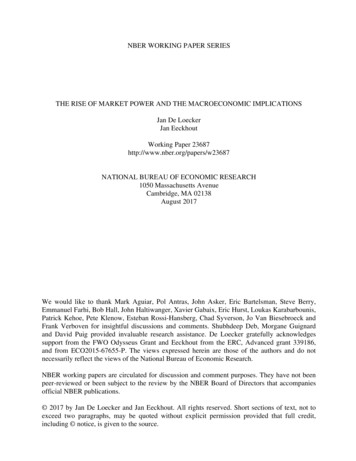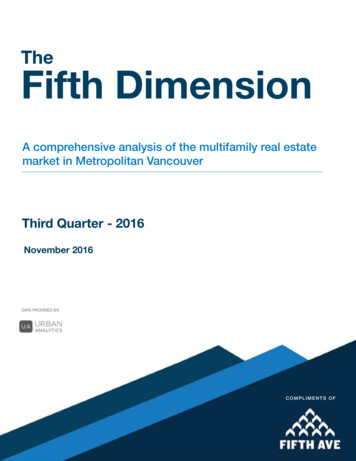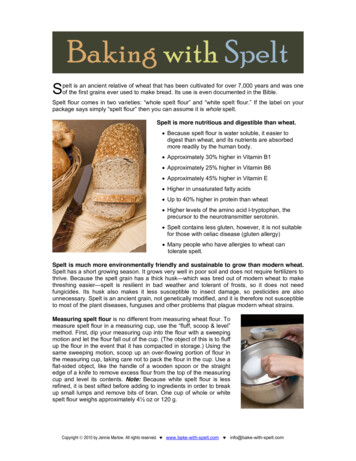
Transcription
NBER WORKING PAPER SERIESTHE RISE OF MARKET POWER AND THE MACROECONOMIC IMPLICATIONSJan De LoeckerJan EeckhoutWorking Paper 23687http://www.nber.org/papers/w23687NATIONAL BUREAU OF ECONOMIC RESEARCH1050 Massachusetts AvenueCambridge, MA 02138August 2017We would like to thank Mark Aguiar, Pol Antras, John Asker, Eric Bartelsman, Steve Berry,Emmanuel Farhi, Bob Hall, John Haltiwanger, Xavier Gabaix, Eric Hurst, Loukas Karabarbounis,Patrick Kehoe, Pete Klenow, Esteban Rossi-Hansberg, Chad Syverson, Jo Van Biesebroeck andFrank Verboven for insightful discussions and comments. Shubhdeep Deb, Morgane Guignardand David Puig provided invaluable research assistance. De Loecker gratefully acknowledgessupport from the FWO Odysseus Grant and Eeckhout from the ERC, Advanced grant 339186,and from ECO2015-67655-P. The views expressed herein are those of the authors and do notnecessarily reflect the views of the National Bureau of Economic Research.NBER working papers are circulated for discussion and comment purposes. They have not beenpeer-reviewed or been subject to the review by the NBER Board of Directors that accompaniesofficial NBER publications. 2017 by Jan De Loecker and Jan Eeckhout. All rights reserved. Short sections of text, not toexceed two paragraphs, may be quoted without explicit permission provided that full credit,including notice, is given to the source.
The Rise of Market Power and the Macroeconomic ImplicationsJan De Loecker and Jan EeckhoutNBER Working Paper No. 23687August 2017JEL No. D2,D4,E2,J3,K2,L1ABSTRACTWe document the evolution of markups based on firm-level data for the US economy since 1950.Initially, markups are stable, even slightly decreasing. In 1980, average markups start to rise from18% above marginal cost to 67% now. There is no strong pattern across industries, thoughmarkups tend to be higher, across all sectors of the economy, in smaller firms and most of theincrease is due to an increase within industry. We do see a notable change in the distribution ofmarkups with the increase exclusively due to a sharp increase in high markup firms.We then evaluate the macroeconomic implications of an increase in average market power, whichcan account for a number of secular trends in the last 3 decades: 1. decrease in labor share, 2.increase in capital share, 3. decrease in low skill wages, 4. decrease in labor force participation, 5.decrease in labor flows, 6. decrease in migration rates, 7. slowdown in aggregate output.Jan De LoeckerDepartment of Economics307 Fisher HallPrinceton UniversityPrinceton, NJ 08544-1021and KU Leuvenand also NBERjdeloeck@princeton.eduJan EeckhoutDepartment of EconomicsUniversity College London30 Gordon StreetLondon WC1H 0AXj.eeckhout@ucl.ac.uk
1IntroductionThe macroeconomy is experiencing a fundamental long term change in the last decades at alower frequency than the business cycle. This manifests itself in a number of secular trends:some are related to labor market outcomes such as a declining labor share, declining wagesand declining labor force participation; others to the slowdown in labor market dynamism withdecreased job mobility and lower migration rates; and yet others are related to the capital shareand the growth of output. While many explanations have been proposed for each of thesesecular trends, in this paper we argue that all these trends are consistent with one commoncause that hitherto has remained undocumented, the rise in market power since 1980.1The presence of market power has implications for welfare and resource allocation. Firmsthat can command a price above marginal cost produce less output. In addition to loweringconsumer welfare, this has implications for factor demand, for the distribution of economicrents, and for business dynamics such as entry and exit, and resource allocation. In this paperwe aim to achieve two goals. First, we document the evolution of markups for the US economysince 1950. Based on firm-level data, we find that while market power was more or less constantbetween 1950 and 1980, there has been a steady rise in market power since 1980, from 18%above cost to 67% above cost. Over a 35 year period, that is an increase in the price levelrelative to cost of 1% per year. Second, we investigate the macroeconomic implications of thisrise in market power and the general equilibrium effects it has. We show that the rise in marketpower is consistent with seven secular trends in the last three decades.While there is ample evidence that market power exists for particular markets and that it ispervasive across sectors, there is surprisingly little systematic evidence of the patterns of market power across the aggregate economy, and over time. The evidence on market power wedo have comes from case studies of specific industries for which researchers have access to detailed data and for which they can estimate markups as a proxy for market power. The estimation of markups traditionally relies on assumptions on consumer behavior coupled with profitmaximization, and an imposed model of how firms compete, e.g., Bertrand-Nash in prices.The fundamental challenge that this approach confronts is the notion that marginal costsof production are fundamentally not observed, requiring more structure to uncover it from thedata. Optimal pricing therefore relates observed price data to estimates of substitution elasticities to uncover the marginal cost of production, and consequently the markup. The combination of requiring data on consumer demand (containing prices, quantities, characteristics,consumer attributes, etc.) and the need for specifying a model of conduct, have limited the useof the so-called demand approach to particular markets.In this paper we follow a radically different approach to estimate markups, following recent advances in the literature on markup estimation by De Loecker and Warzynski (2012) thatbuilds on Hall (1988), the so-called production-approach. This approach relies on individualfirm output and input data, covering a panel of producers over time, and in contrast to the1Outside of the academic literature it has received significant attention, e.g. A lapse in concentration (TheEconomist, September 2016), and the CEA Issue Brief, Benefits of Competition and Indicators of Market Power(May 2016).2
demand approach described above, posits cost minimization by producers. A measure of themarkup is obtained for each producer at a given point in time as the wedge between a variableinput’s expenditure share in revenue (directly observed in the data) and that input’s outputelasticity. The latter is obtained by estimating the associated production function. The advantage of this approach is twofold. First, the production approach does not require to modeldemand and/or specify conduct, and this for many markets over a long period of time. Second, we can rely on publicly available sources providing us with production data. While therestill exist many measurement issues and associated econometric challenges, to our knowledgethere is no viable alternative to make progress.2 This method allows us to uncover the basicpattern of market power over a long period of time and across the entire economy.This paper starts by documenting the main patterns of markups in the US economy overthe last six and a half decades, and in doing so we provide new stylized facts on the crosssection and time-series of markups. This analysis is interesting and important in its own rightas increasingly economic models allow for meaningful markup variation across producers andtime; and allowing for this firm/time variation has substantially different implications for avariety of questions.3We observe all publicly traded firms covering all sectors of the US economy over the period 1950-2014, provided by Compustat. Because there is no official filing requirement for theprivately held firms, our data does not include any privately held firms.4 And while publiclytraded firms are relatively few relative to the total number of firms, because the public firmstend to be the largest firms in the economy, they account for one third of total US employment(Davis, Haltiwanger, Jarmin, and Miranda (2007)) and about 41% sales (Asker, Farre-Mensa,and Ljungqvist (2014)). Moreover, publicly trade firms cover all sectors and industries Ourmain finding is that while average markups were fairly constant between 1960 and 1980 ataround 1.2 (slightly decreasing from 1.27 to 1.18), there was a sharp increase starting in 1980with average markups reaching 1.67 in 2014. In 2014, on average a firm charges prices 67%over marginal cost compared to only 18% in 1980. Over a period of 35 years, that is an increasemarkup rate by a factor of 3.6.5 Moreover, the increase is becoming more pronounced as timegoes on, especially after the 2000 and 2008 recessions. Second, there are marked changes inthe distribution of markups over time. The increase occurs mainly in the top of the markupdistribution. Markups in the top percentiles of the distribution go up most (from 1.4 in 1980to 2.6 in 2014 for the 90th percentile), whereas those in the lower percentiles are flat or evendecreasing. The median markup goes up, but only slightly so and substantially less than the2De Loecker and Scott (2016) apply both methods – the demand approach and the production approach – toestimate markups in the US beer industry, and find that they yield very similar markup estimates.3For example, markup variability is found important in quantifying the gains from trade, Melitz and Ottaviano(2008) and Edmonds, Midrigan, and Xu (2015), where trade reforms are best thought of as (exogenous) changes tocompetition and cost structures of firms.4Until the US Inland Revenue Service gives researchers access to the information on tax declaration data of allprivately held firms, this remains impossible.5The only other attempts at measuring markups economy-wide that we have found in the literature are basedon industry level aggregate data, and for the period up to the 1980s. Both Burnside (1996) and Basu and Fernald(1997) find little evidence of market power (nor of returns to scale or externalities), which is consistent with ourfinding that market power only picks up after 1980.3
average markup. Third, there is no strong compositional pattern across industries and the increase occurs mainly within industry. Finally, across industries it is mainly the smaller firmsthat have higher markups, though this effect disappears at a narrow industry specification,indicating that there is systematic size differences across industries. Within narrowly-defined(here 4 digit) industries firm size and markups are positively correlated.After we establish these main facts, we take these as given and we discuss the implicationsof the rise in market power for recent debates in the macro/labor literature. We take the risein markups as given, and we do not engage in the analysis of how this happened, which liesbeyond the scope of this paper, though we provide the reader with a few promising candidatesin the concluding remarks. In particular, we show how the rise in markups naturally gives riseto a decrease in the labor share, a decrease in the capital share, a decrease in low skilled wages,a decrease in labor market participation, and decrease in job flows, a decrease in interstatemigration, and finally, we show that properly accounting for the rise in markups, there is noproductivity slowdown but instead an increase in productivity despite the fact that outputgrowth has slowed down.At a general level, our findings warrant a more systematic analysis of the aggregate impact,if any, of market power on a variety of outcomes of interest. While there was a tradition to investigate the potential impact of market power on resource allocation, the analysis of Harberger(1954) concluded that profit rates across US (manufacturing) industries during the 1920s werenot sufficiently dispersed to generate any meaningful aggregate outcome. This analysis, andits conclusion that market power barely impacts economy-wide outcomes, became the defaultview held by many economists and policy makers ever since.6The paper is organized as follows. In Section 2 the data and empirical framework to recover markups is presented. The main facts on markups, in both the cross-section and the timeseries, are presented in Section 3. We derive the macroeconomic implication in Section 4, taking the facts from the previous section as given, building on a stylized model of market-levelcompetition and an aggregate labor market. We conclude in Section 5.2Empirical FrameworkIn this section we discuss the empirical framework and the main data source we rely on to describe the patterns of markups in the US economy. In particular, we observe firm-level outputand input data for firms across the US economy. This data is sufficient to measure firm-levelmarkups using minimal assumptions on producer behavior, but without assumptions on product market competition and consumer demand. We apply the method proposed by De Loeckerand Warzynski (2012), and we discuss the implementation.6See Asker, Collard-Wexler, and De Loecker (2017) for a discussion, and an application to the oil industry.4
2.1DataThe choice of data is driven entirely by the ability to cover the longest possible period of time,and to have a wide coverage of economic activity. This for example rules out using the censusof manufacturing establishments, given the decreasing share of manufacturing in the overallemployment of US economy, from about 25% in 1960 to 9% in 2014 (Baily and Bosworth (2014)).To our knowledge, Compustat is the only data source that provides substantial coverage offirms in the private sector over a substantial period of time, covering the period 1950 to 2014.While publicly traded firms are relatively few relative to the total number of firms, because thepublic firms tend to be the largest firms in the economy, they account for one third of total USemployment (Davis, Haltiwanger, Jarmin, and Miranda (2007)) and about 41% sales (Asker,Farre-Mensa, and Ljungqvist (2014)).There are two alternatives to using our publicly trade firms data. A first alternative datasource is the Census of Manufacturing, but it accounts for only 8.8% of US employment in 2013.Moreover, the Census of Manufacturing is – by construction – highly selective in the sectorsand industries covered. We establish in Appendix B.1 that for manufacturing only, the sameresult holds. A second alternative data source is to use aggregate industry-level data ratherthan micro-level data, as originally done by Hall (1988). We perform this robustness analysisin Appendix B.4 both on aggregate IRS data and an aggregation of our own data of publicfirms. The aggregate patterns across the (aggregate) Compustat dataset and the economy-wideprivate sector (using IRS) are very similar.The Compustat data contains firm-level balance sheet information, which allows us to relyon the so-called production approach to measuring markups, and market power. In particularwe observe measures of sales, input expenditure, capital stock information, as well as detailedindustry activity classifications.7 In addition, we observe relevant, and direct accounting information of profitability and stock market performance. The latter information is useful toverify whether our measures of markups, as discussed below, are at all correlated to the overallevaluation of the market. Table A.1 in the Appendix provides basic summary statistics of thefirm-level panel data used throughout the empirical analysis.2.2Markup estimationMeasuring markups is notoriously hard as marginal cost data is not readily available, let aloneprices, for a large representative sample of firms. The standard approach in modern Industrial Organization is to specify a particular demand system that delivers price-elasticities ofdemand, which combined with assumptions on how firms compete, in turn deliver measuresof markups through the first order condition associated with optimal pricing. This approach,while powerful in other settings, is not useful here for two distinct reasons. First, we do notwant to impose a specific model of how firms compete across a dataset of large firms, or com7The Compustat data has been used extensively in the literature related to issues of corporate finance, such asCEO pay, e.g. Gabaix and Landier (2008), but also for questions of productivity and multinational ownership, e.g.Keller and Yeaple (2009).5
mit to a particular demand system for all the products under consideration. Second, even ifwe wanted to make all these assumptions, there is simply no information on prices and quantities at the product level for a large set of sectors of the economy, over a long period of time,to successfully estimate price elasticities of demand, and specify particular models of pricecompetition for all sectors.We rely on a recently proposed framework by De Loecker and Warzynski (2012), based onthe insight of Hall (1988) to estimate (firm-level) markups using standard balance sheet dataon firms, which does not require to make assumptions on demand and how firms compete. Instead markups are obtained by leveraging cost minimization of a variable input of production.This approach requires an explicit treatment of the production function.2.2.1Producer behaviorConsider an economy with N firms, indexed by i 1, ., N . Firms are heterogeneous in theirproductivity and otherwise have access to a common production technology. In each period t,firm i minimizes the contemporaneous cost of production given the production function thattransforms inputs into the quantity of output Qit produced by the technology Q(·):Q(Ωit , Vit , Kit ) Ωit Ft (Vit , Kit ),(1)where V (V 1 , ., V J ) captures the set of variable inputs of production (including labor, intermediate inputs, materials,.), Kit is the capital stock and Ωit is the Hicks-neutral productivityterm that is firm-specific. Because in the implementation we will use information on a bundleof variable inputs, and not the individual inputs, in the exposition we treat the vector V as ascalar V . Following De Loecker and Warzynski (2012) we consider the associated Lagrangianobjective function:L(Vit , Kit , Λit ) PitV Vit rit Kit Λit (Q(·) Qit ),(2)where P V is the price of the variable input, r is the user cost of capital,8 Q(·) is the technology(1), Qit is a scalar and Λit is the Lagrangian multiplier. We consider the first order conditionwith respect to the variable input V , and this is given by: Lit Q(·) PitV Λit 0. Vit Vit(3)Multiplying all terms by Vit /Qit , and rearranging terms yields an expression of the outputelasticity of input V : Q(·) Vit1 PitV VitVθit .(4) Vit QitΛit Qit8For our purpose here, we maintain the assumption that input markets are competitive and hence P V and r areequal to marginal revenue product. If they were not, then this will affect the marginal cost and hence the estimateof the markup. The are two opposing effects of market power in the inputs market: 1. Double marginalization, bywhich the marginal cost of inputs would be higher than under competition; 2. Monopsony power, where the firmssqueezes the upstream provider and obtains lower input prices. The measured markup will be biased but it is notclear in which direction. For an analysis with non-competitive inputs, see De Loecker, Goldberg, Khandelwal, andPavcnik (2016).6
The Lagrangian parameter Λ is a direct measure of marginal cost – i.e. it is the value of theobjective function as we relax the output constraints. We define the markup as µ PΛ , whereP is the price for the output good, which depends on the extent of market power. We returnto that below. Substituting marginal cost for the markup to price ratio, we obtain a simpleexpression for the markup:V Pit Qitµit θit.(5)jPitV VitThe expression of the markup is derived without specifying conduct and/or a particular demand system. Note that with this approach to markup estimation, there are in principle multiple first order conditions (of each variable input in production) that yield an expression forthe markup. Regardless of which variable input of production is used, there are two key ingrePV Vdients needed in order to measure the markup: the revenue share of the variable input, Pitit Qitit ,V . While this approach does not restrict theand the output elasticity of the variable input, θitoutput elasticity, when implementing this procedure it depends on a specific production function, and assumptions of underlying producer behavior in order to consistently estimate thiselasticity in the data. We turn to the implementation next.2.2.2ImplementationPjWe directly observe sales, Sit Pit Qit and total variable cost of production, Cit j PitV Vitj ,measured by the cost of goods sold. The Compustat data does not directly report a breakdownof the expenditure on variable inputs, such as labor, intermediate inputs, electricity, and others,and therefore we prefer to rely on the reported total variable cost of production.9In order to recover markups an estimate of the output elasticity of this input bundle is required. We follow standard practice and rely on a panel of firms, for which we estimate production functions by industry. In particular we consider various specifications of the productionfunction, both at the level of the economy and the industry. For the main results we considerindustry-specific Cobb-Douglas production functions, with variable inputs and capital.10For a given industry we consider the production function:qit βv vit βk kit ωit it ,(6)where lower cases denote logs and ωit ln Ωit , and where qit is measured as the log of deflatedfirm level sales.11 We follow the literature and control for the simultaneity and selection bias,inherently present in the estimation of the above equation, and rely on a control function approach, paired with an AR(1) process for productivity to estimate the output elasticity of the9We verify the robustness of our main findings to obtaining markup estimates using intermediate inputs only asthe variable input. The latter, however, requires additional assumptions on how to derive a measure of intermediateinput use from operating income before depreciations, and the total wage bill, where the latter is imputed frommultiplying the reported total number of employees with industry-wide wage data, as done in e.g. Keller andYeaple (2009).10We also consider more flexible translog production functions, and Cobb-Douglas production functions withtime-varying coefficients. Appendix B discusses the main findings using these alternative specifications.11See De Loecker and Warzynski (2012) for a discussion of the measurement of sales and quantities.7
variable input, here βv .12 The attractive feature of this approach, in our context, is that the control function approach rests on an optimal input demand equation, which is immediate in thecost minimization framework used to recover an expression for the markup. In particular, theinsight from Olley and Pakes (1996) is that the (unobserved) productivity term ωit is given by afunction of the firm’s inputs and a control variable, in our case the variable input bundle; suchthat ωit h(vit , kit ).This approach relies on a so-called two-stage approach where in the first stage, the measurement error and unanticipated shocks to sales are purged using:qit φt (vit , kit ) it ,(7)where φ βv vit βk kit h(vit , kit ). The productivity process is given by ωit ρωit 1 ξit ,and this gives rise to the following moment condition to obtain the industry-specific outputelasticity:E(ξit (βv )vit 1 ) 0,(8)where ξit (βv ) is obtained, given βv , by projecting productivity ωit (βv ) on its lag ωit 1 (βv ), whereproductivity is in turn obtained using φit βv vit βk kit , using the estimate φ from the firststage regression of sales on a non-parametric function in the variable input and capital, andyear dummies. This approach identifies the output elasticity of a variable input under theassumption that the variable input use responds to productivity shocks, but that the laggedvalues do not, and more importantly, that lagged variable input use is correlated with currentvariable input use, and this is guaranteed through the persistence in productivity.We measure firm-level markups using the estimate of the output elasticity:µit βvSit.Cit(9)As discussed in De Loecker and Warzynski (2012) we correct the markup estimates forthe presence of measurement error in sales, it , which we obtain in the first stage regression(equation (7)).3The Evolution of MarkupsIn this section we present the key stylized facts of markups across the US economy and overtime. We document the steady increase in overall markups, and decompose this trend acrossand within sectors. The drastic increase in markups is further decomposed across the percentiles of the markup distribution, and the time-series properties of markups are discussed.Finally, the link from rising markups to market power is made through auxiliary data on profits, dividends and market valuations.12We estimate the production function, by industry, over an unbalanced panel to deal with the non-random exitof firms, as found important in Olley and Pakes (1996). However, the source of the attrition in the Compustat datais likely to be different than in traditional plant-level manufacturing datasets – i.e., firms drop out of the data due toboth exit, and mergers and acquisition, and as such the sign of the bias induced by the selection is ambiguous. Weare, however, primarily interested in estimates of the variable output elasticity, while the selection bias is expectedto impact the capital coefficient more directly.8
3.1A Secular Trend since 1980Figure 1 presents the weighted average markup, across the economy, over time where weightsare based on firm-level sales. Average markups have gone up since the 1980s. In the beginningof the sample period markups were stable and slightly decreasing from 1.27 in the 1960 to 1.18in 1980. Since 1980 there has been a steady increase to 1.67. In 2014, the average firm charges67% over marginal cost, compared to 18% in 1980. In Appendix B.5 we report some individualfirms’ markups.1.7Markup 10yearFigure 1: The Evolution of Average Markups (1960 - 2014). Average Markup is weighted bymarketshare of sales in the sample.It is well known that the Compustat data is a selected sample and we therefore compareour result to aggregate data from the IRS, and further compare it to the aggregated version ofour data (Compustat). The figures in the Appendix B.4 confirm that these same pattern holds,at the aggregate level, although there is a more modest increase in market power for aggregatedata. The patterns, however, across the (aggregate) Compustat dataset and the economy-wideprivate sector (using IRS) are very similar. This highlights the importance of using micro-leveldata and that industry-level data cannot fully capture the increase in market power. We turnto the micro dimension next.3.2Decomposition: Markups and Firm SizeThe construction of our measure of markup uses weights given by the sales share of the firmin the economy.13 When we compare our measure with the unweighted average of markup13The pattern of aggregate markup depends on the aggregation weight used. The share of Sales is the most common, see for example the HHI index. So far we made no assumption on demand and hence there is no welfaremeasure that guides us which aggregation weight to use. In the Appendix we report aggregate markups for alternative aggregation weights employment and the value of variable inputs. We also report the joint distribution ofthe individual markup and the corresponding weight variable. The pattern of the increase in markups starting in9
in Figure 2a, we observe that the unweighted average is even higher and also increasing morethan our benchmark measure: the unweighted markup goes from 1.4 in 1980 to 2.3 in 2014(and was fairly constant throughout the 1960s and 1970s), compared to an increase from 1.18to 1.67 for the unweighted measure. The fact that the unweighted measure is always higherindicates that larger firms (as measured by their sales) tend to have a lower markup. Thisappears at first to contradict the prediction from models of imperfect competition where firmswith larger market shares have higher markups. Of course, the previous results hold acrossall firms across all sectors, while within narrowly defined industries, however, we confirm thepositive relationship between markups and firm 02010194019601980year20002020yearShare weighted Markupmu meanMarkup(a) Unweighted versus Weighted Markup.Mean 4digit(b) Industry disaggregationFigure 2: Decomposition by market share.We seek to decompose the weighted mean to get at the source of this discrepancy in thelevel with the unweighted measure and to get at what has changed over time that can explainthe rise in markup. If in the total population, large firms have smaller markups, is this alsothe case at more disaggregated levels of industry? Is the change over time due to an overallincrease in markup (the markup tide has been lifting across all industries) or is there a changein the composition of firms of different sizes?We therefore investigate whether this negative relation between markup and sales is due tothe composition of industry or due to the negative relation between size and markup, and usea decomposition method as in Olley and Pakes (1996).T HE CROSS - SECTIONAL DECOMPOSITION . Denote the share sit of firm i’s sales Sit Pit Qit inthe total sales St in the economy (the universe of firms in our sample) by sit SSitt . Then wecan write the weighted markup, denoted by Mt , asXMt sit µiti µt X(sit st )(µit µt )i1980
power is consistent with seven secular trends in the last three decades. While there is ample evidence that market power exists for particular markets and that it is pervasive across sectors, there is surprisingly little systematic evidence of the patterns of mar-ket power across the aggregate economy, and over time. The evidence on market power we










